In vitro examination of the primary stability of three press-fit acetabular cups under consideration of two different bearing couples.
Jahnke A 1, Bott CC 2, Fonseca Ulloa CA 2, Jahnke GW 2, Rickert M 3, Ishaque BA 3, Ahmed GA 3
Med Eng Phys. 2019 May;67:49-54. doi: 10.1016/j.medengphy.2019.03.008.
Epub 2019 Mar 19.PMID: 30902521
- Laboratory of Biomechanics, Justus-Liebig-University Giessen, Klinikstrasse 29, 35392 Giessen, Germany. Electronic address: Alexander.Jahnke@ortho.med.uni-giessen.de
- Laboratory of Biomechanics, Justus-Liebig-University Giessen, Klinikstrasse 29, 35392 Giessen, Germany.
- Laboratory of Biomechanics, Justus-Liebig-University Giessen, Klinikstrasse 29, 35392 Giessen, Germany; Department of Orthopaedics and Orthopaedic Surgery, University Hospital Giessen and Marburg (UKGM), Klinikstrasse 33, 35392 Giessen, Germany.
BACKROUND:
For preclinical statements about the anchoring behavior of prostheses, the primary stability of the prosthesis is of special importance. It was the aim of this study to examine and compare the relevant relative micromotions of three different acetabulum prostheses by introducing three-dimensional torques.
METHODS:
The cups were implanted under standard conditions into an anatomical artificial bone model. Three-dimensional torques were applied to the acetabular cups. Taking into account the resulting frictional moments of two different bearing couples, ceramic-on-ceramic and ceramic-on-polyethylene, the relative micromotions of the cups were recorded as maximum total micromotion, translational and rotational micromotion, and the primary stability values of the three cups were compared.
RESULTS:
Relative micromotion of all cup models was always significantly smaller with the CoC bearing couples than with the CoP bearing couples (p < 0.001). The rotational micromotion was always lower (p < 0.001) than the translational micromotion, and the rotational as well as the translational micromotions were each always lower than the maximum total micromotion (p < 0.001, p < 0.010). The thinnest-walled cup system always showed the largest relative micromotions.
CONCLUSION:
The results of our study can be interpreted as indicating that the low relative micromotions of all cups – irrespective of the use of CoC or CoP bearing couples – are within an acceptable range favoring secondary osseointegration of the implants. Furthermore, we were able to show that the cup wall thickness and the surface quality of the cup systems have an influence on the primary stability and the elastic deformability of the examined cup systems.
KEYWORDS:
Acetabular component; Cementless; Friction torques; Hip arthroplasty; Primary stability
PMID: 30902521
DOI: 10.1016/j.medengphy.2019.03.008
